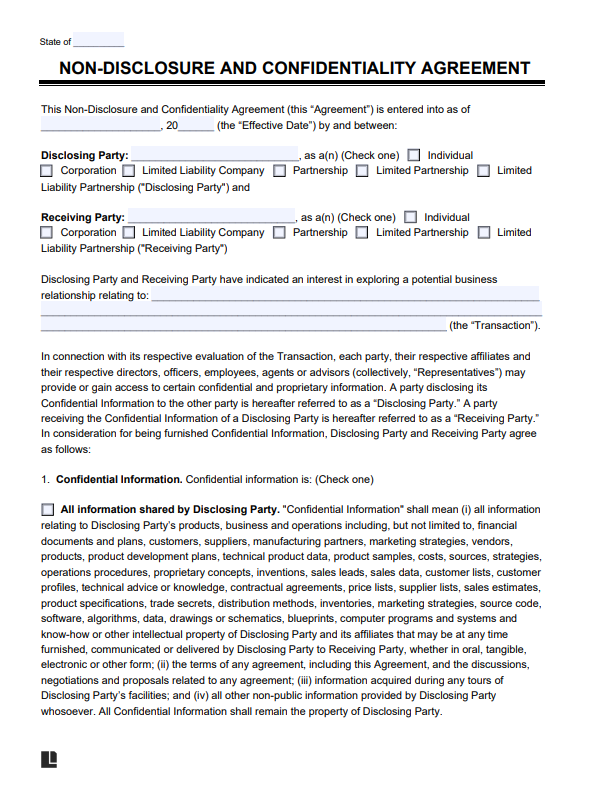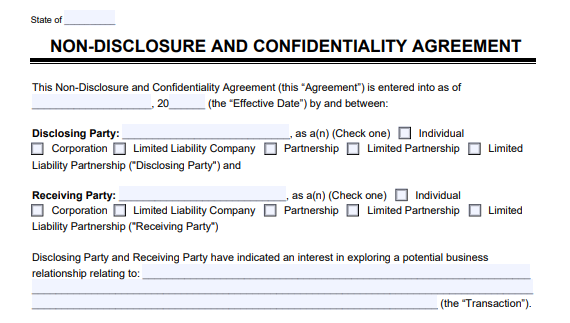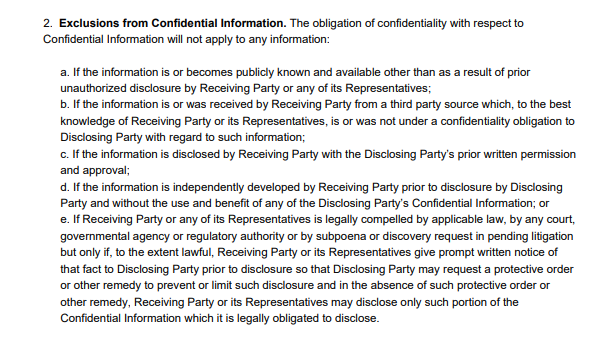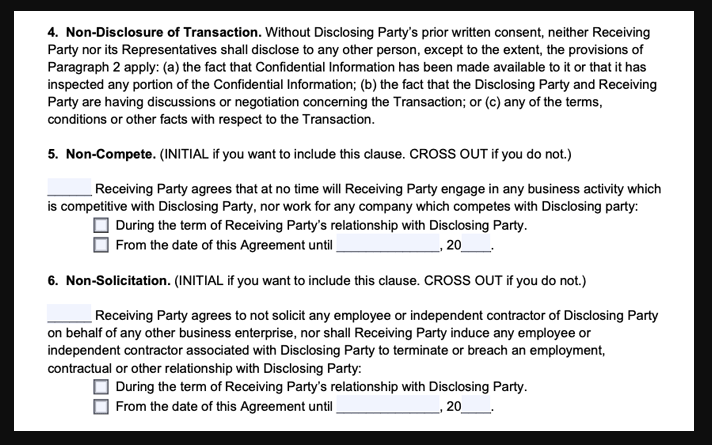A Non-Disclosure Agreement is a contract between two parties promising to keep given information confidential or secret. Confidential information is considered sensitive, Personal, commercial, or valuable in nature (e.g., trade secrets, proprietary information, Database, Presentations).
Both parties sign a non-disclosure agreement, forming a binding contract to keep confidential information secret. Make sure you understand how to write a Non-Disclosure Agreement before drafting your own.

All of the above non-disclosure agreement templates are blank, fillable and free to download. These include all the necessary clauses and language to keep your confidential information private.
However, using our free legal document builder, it is easy to get a non-disclosure agreement in minutes.
How to write Non-Disclosure Agreement: General section
You may want to fill or write your non-disclosure agreement. Here are the standard sections you should include and what they mean:
-
To favor and receive
Start your NDA by establishing “parties” to the agreement. The “disclosing party” is the person or entity sharing information, while the “receiving party” is the person or entity receiving the information.
In a mutual NDA (also known as bilateral NDA), confidential information has shared both ways. In this agreement, both parties act as the disclosing and receiving parties.
Here is an example of how to start an NDA and set up the parties to the agreement. Note that the sample NDA clause also specifies what transactions or relationships the NDA has:

2. Confidential or Secret information
After the parties are established, specify which the non-disclosure agreement protects confidential information.
Common examples of NDA-protected personal information include:
Trade secret
- Special formulas
- the manner
- Tools
- Software development
- Technical design
- Blueprint
- Customer list
- Patent statement
business ventures
- Affiliate deals
- Participation
- Fusion
- real estate
- discussion
- Audit
- advertising and marketing
- Pricing structures
- Business and financial records
other
- Visitor or factory tour
- Undergraduate or graduate parties
- self-service
- Celebrities meet and hit the road
- Home visits
- Original artwork
These are just a few examples of the type of confidential information you hold under the protection of your NDA.
Your agreement may list as many or as few personal information items as required, but you must be specific about what information the recipient party is not allowed to disclose.
Being specific about the information protected by your NDA will help it stand up in court in the event of a legal dispute
3. Exceptions of Confidential information
The “Exceptions” clause defines which type of information is not protected by the NDA.
Information to be protected by a non-disclosure agreement includes:
- Information already in the public domain
- The other party is already aware of accessing the NDA
- Information that the rejection party has authorized the receiving party to share with the prior written consent
- Verbal information may be considered confidential information unless confirmed in writing within a specific timeframe after it is disclosed.
Here’s an example of what your exclusion clause should look for:

DOWNLOAD LINK ( CLICK HERE )
4. Non-disclosure obligations
The bulk of your NDA will be made up of non-disclosure obligations, which outline the recipient party’s responsibilities to disclose party information. Instead of being a single clause, this section will consist of multiple clauses involving multiple obligations.
This section will begin with a clause similar to the example below, which states the recipient party’s general obligation to keep confidential information quiet.
Example NDA nondisclosure obligations section
You can add additional sections to this section of your NDA, depending on your needs. Here are some other areas you can choose to include in your non-disclosure violations section:
- Non-disclosure of transactions: The receiving party promises not to tell others that:
- The transaction is being discussed or negotiated.
- A transaction has occurred, including the details of the relationship.
- Non-Solicitation: Either party may stop soliciting the other or employing the other party’s employees or may prohibit the other party from doing business.
- Non-Competition: The parties do not agree to engage in business activities that compete directly with the other party. Many companies choose their partners and employees to sign separate NDA and non-compete agreements.
- Non-Circulation: If the disclosing party is sharing business contacts, a non-periphery clause prevents the receiving party from bypassing the agreement and directly trading or engaging with those contacts.
In the NDA sample below, you can see how these clauses in the agreement might look:

DOWNLOAD LINK ( CLICK HERE )
5. Signature
Finally, your NDA needs to include the signatures of all parties and their representatives.
Delegates are other people (ie, directors, officers, employees, agents, or consultants) who may share, receive, or preserve information in search of transactions specified in the NDA.
This disclosure is an example of the signature section of the party:

DOWNLOAD LINK ( CLICK HERE )
YOU CAN ALSO VISIT: LEGALTEMPLATE
